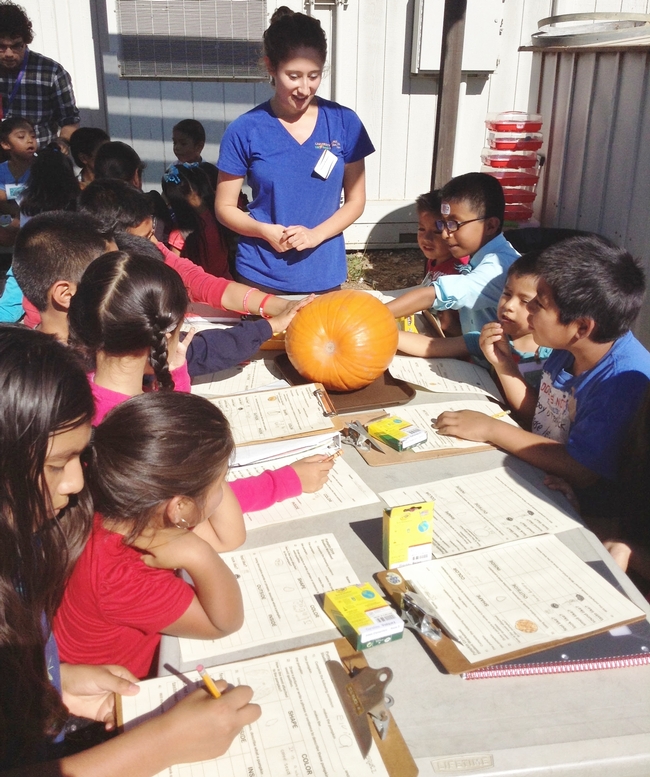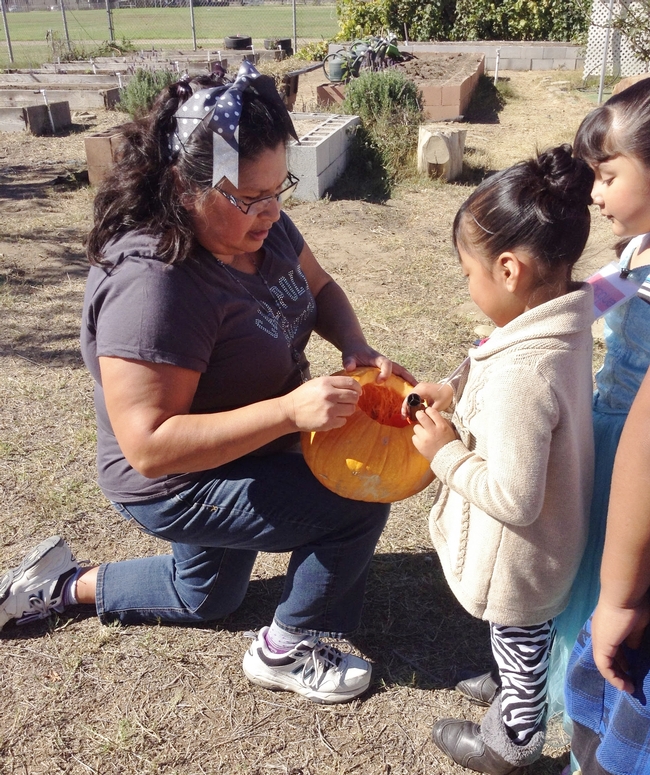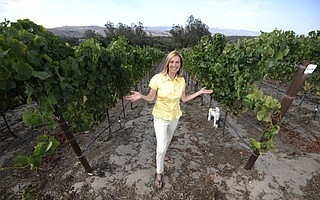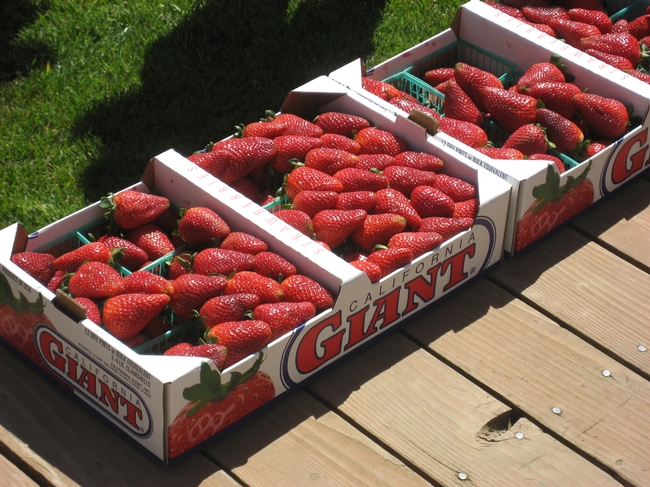
Posts Tagged: Santa Maria
Planting the seeds for garden-based education

Each school day, teachers must carefully plan and account for their instructional minutes. For each grade level has specific time recommendations for math and English language arts, so teachers often feel they do not have the time to include extra activities in their already packed schedules. When UC CalFresh gave a brief survey to teachers a Santa Maria school last year, teachers identified the following barriers to using their school garden for instruction:
- Lack of instructional time or preparation time
- Lack of curriculum and learning activities
- Too many students to manage in the outdoor setting
These concerns reflected comments that UC CalFresh nutrition educators frequently heard from teachers who were invited to bring their students to the school garden.
Taking these concerns into consideration, UC CalFresh developed innovative strategies to meet the needs of school teachers, showing how instructional minutes in the garden don't have to be “extra” and can include hands-on learning for English language arts and math, with a focus on nutrition. The strategies include:
- Clearly aligning garden-based nutrition education with common core lessons
- Providing garden-based curriculum and materials for learning activities in the garden
- Hosting Garden Open House Days, during which teachers can bring their students to the garden when UC CalFresh Educators are present to increase educator-to-student ratios.

The first No-Prep Garden-Based Nutrition Education Kit was piloted in October and featured pumpkins. The No-Prep Kit became fondly known as the Pumpkin Kit. The Pumpkin Kit encouraged teachers to take the lesson out to the garden, increasing students' physical activity time while providing opportunities for students to practice common core skills. The kit focuses on nutrition and cooking while reinforcing math, science and language arts. The kit includes books, worksheets, an oven, and several different pumpkins for measuring, cooking, estimating, and tasting. This kit requires no teacher prep time, is adaptable to any primary grade level, and is an easy introduction to garden-based lesson delivery.
During a Garden Open House Day hosted by UC CalFresh in October, kindergarten students and their fifth-grade buddies came out to the garden. The fifth-grade buddies worked with the kindergarten students to use observation skills (five senses), learn adjectives, and draw the pumpkin life cycle. The older buddies gained teaching and language arts skills while working with their little buddies in the garden. Students got to dissect the pumpkins in teams and used the seeds for counting. Each kindergartener took 20 seeds home to practice counting with their parents, which also served as a budding connection for students' families and the school garden.
"If we had something like this every month, we would be able to go out into the garden more and maybe we could get more teachers to come. This is what we need, curriculum that can be used in the garden," said kindergarten teacher Mrs. Joaquin.

“The program has been awesome," said one fourth-grade teacher. "[UC CalFresh] incorporated math, science, social studies into lessons. Students were excited and engaged. Many tried new vegetables they'd never had before and liked them! Kids learned responsibility and pride in designing, choosing plants, maintaining and harvesting in school garden.”
For more on UC CalFresh of San Luis Obispo and Santa Barbara counties see the Facebook page at facebook.com/uccalfreshslosb
UC CalFresh nutrition education is offered in schools jointly by UC Agriculture and Natural Resources and USDA.
UC Small Farm Advisor works with grower to push the "Horticultural Envelope"
This article by Matt Kettman was published in the Santa Barbara Independent on October 6, 2015. UC Small Farm Advisor, Mark Gaskell, has been providing technical assistance to small-scale growers in Santa Barbara and San Luis Obispo counties for more than 20 years. Sandra Newman has established certified organic blueberries, gooseberries, mulberries, and other specialty crops on her 100 acres of sandy soil and been growing and marketing them successfully for more than a dozen years.
Blueberries, Pinot Noir, Mulberries, and More Thrive at Sandra Newman's Forbidden Fruit Farms Near Lompoc
Story by Matt Kettmann

The advisor, however, asked whether she had money and time to burn. As a widow approaching retirement age, lacking a fortune, and still paying bills through her Orange County–based digital SEC filing service, Newman had neither luxury. “I have a budget,” Newman told me during a visit this past summer to the property. “My daddy didn't buy it for me; my husband didn't buy it for me. I'm probably the only one out here who still has a mortgage.”
So the advisor suggested planting blueberries, which, if they ripened anytime other than when the blueberry market is typically flooded, would deliver nearly instant returns. In went two acres of the shrubs — they ripened exactly at the right times — and Forbidden Fruit Orchards was born. Newman was soon selling her organically grown blueberries to upscale grocers and through farmers' markets from San Francisco to Los Angeles, using the proceeds to grow her property from a few abandoned apple trees into a dynamic estate with multiple buildings.
And she kept planting, from more blueberries (now 8.5 acres) to Pakistani mulberries, avocados, apples, red and pink currants, figs, bananas, gooseberries, and more. Among the more interesting choices are the hardy kiwis (smaller than usual and hairless so that you eat the whole thing, but she's still getting them to flower at the right time), green tea (an experimental project in conjunction with the University of California), and hops for beer, which are tended to by Brian DeBolt and Casey Birthisel of Pacific Valley Hops. Many of these items will be integrated into the menu of the upcoming farm-to-table, four-course dinner at the property on November 7, when Chef Sally Ruhl will unveil many of the ingredients she's posting to Twitter under her handle @SallyRuhl.
With the blueberry cash flow, Newman finally did plant wine grapes in 2007, today amounting to 7.5 combined acres of pinot noir and chardonnay. Some grapes are sold to other vintners, but she makes about 600 or so cases in her souped-up garage under the brand Cebada, named after the canyon. The wines are very light and elegant in a deliberately Old World style; the chard is tight and racy, the pinot requires a bit of bottle age to truly shine (so 2011 is great now), and the 2014 rosé is one of the best pinks I've tried of the vintage. Plenty of others think so, too, as it's rare for me to hear so many wine lovers I know rave about the same brand without any prompting.
You can taste them with an appointment at the farm, or just head to Isabella Gourmet Foods on Figueroa Street in downtown Santa Barbara, where Cebada wines are poured upstairs and Newman's jams, teas, and other products are also sold. To get the most bang out of your $10, try them during Thursday and Friday's Classy Hour, when sips come with small food pairings from 4-6 p.m.
Newman also makes a blueberry wine, further evidence that those tiny berries remain the core strength of Forbidden Fruit Orchards. She's currently tending to bidding wars over the recent harvest, since her bushes reach their prime when the market is most desperate. “We hit a really nice window,” she said, “because Chile is not in and the northern hemisphere is done.”
It's certainly not a stress-free existence, and with so many fruits in the air, Newman admits that “sometimes you just have crazy days.” But she's happy with her 100 acres of sand and the evolving cornucopia of trees, vines, and shrubs. “I just love farming,” said Newman. “I love being able to grow and pick the fruit. It's just a passion.”
UC estimates costs for growing strawberries on coast

Each analysis is based upon hypothetical farm operations using practices common in the region. Input and reviews were provided by UC Cooperative Extension farm advisors, UC researchers, growers, farm accountants, pest control advisers, consultants and other agricultural associates.
The studies describe the assumptions used to identify current costs for the individual crops, material inputs, cash and non-cash overhead. A ranging analysis table shows profits over a range of prices and yields. Other tables show the monthly cash costs, the costs and returns per acre, hourly equipment costs, and the whole farm annual equipment, investment, and business overhead costs.
The new studies are as follows:
Sample Costs to Produce Strawberries, 2011, South Coast Region (Santa Maria Valley) by Surendra Dara, Karen M. Klonsky and Richard L. De Moura.
Sample Costs to Produce Strawberries, 2011, South Coast Region (Oxnard Plain) by Oleg Daugovish, Karen M. Klonsky and Richard L. De Moura.
Sample Costs to Produce Second Year Strawberries, 2011, Central Coast Region (Santa Cruz & Monterey Counties) by Mark P. Bolda, Laura Tourte, Karen M. Klonsky and Richard L. De Moura.
All cost of production studies are available for free download at http://coststudies.ucdavis.edu, at UC Cooperative Extension offices or by calling (530) 752-3589. For more information about the studies, contact Richard De Moura at rdemoura@ucdavis.edu in the Department of Agricultural and Resource Economics at UC Davis.
